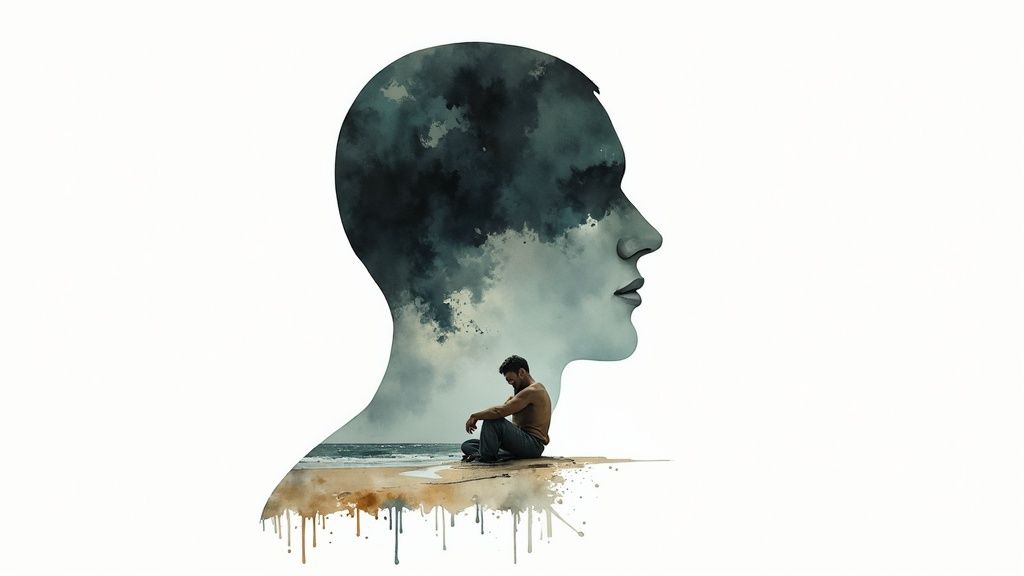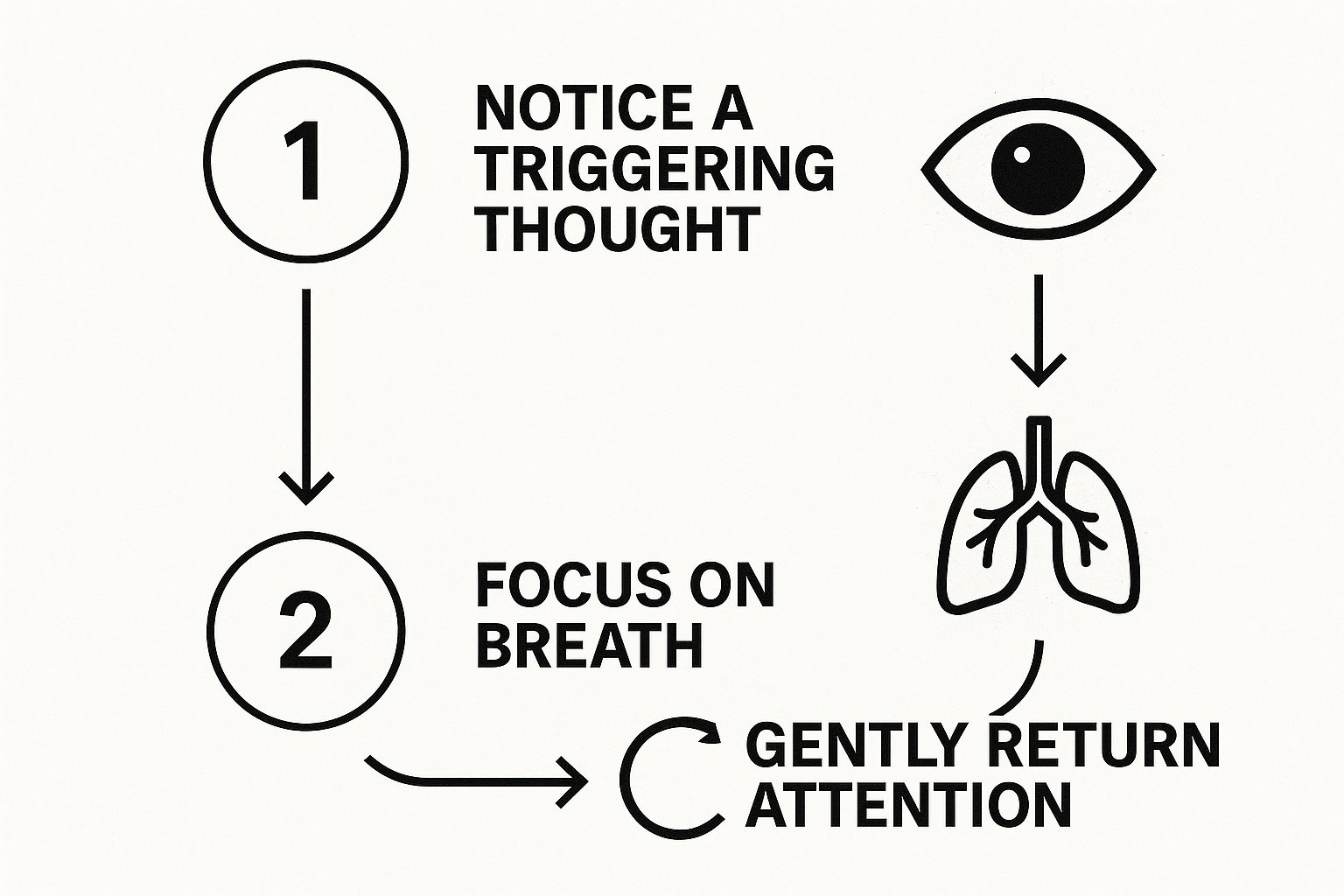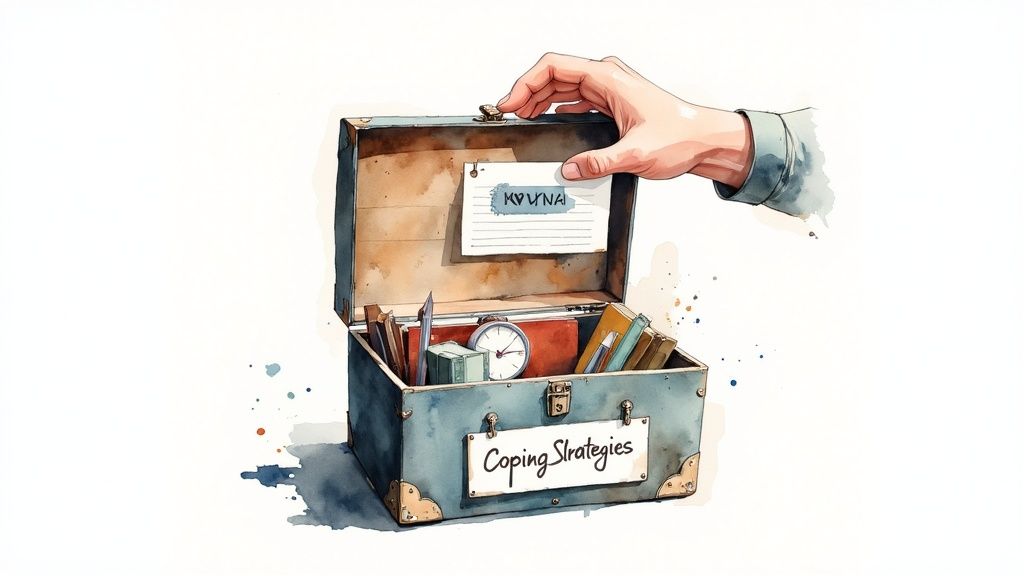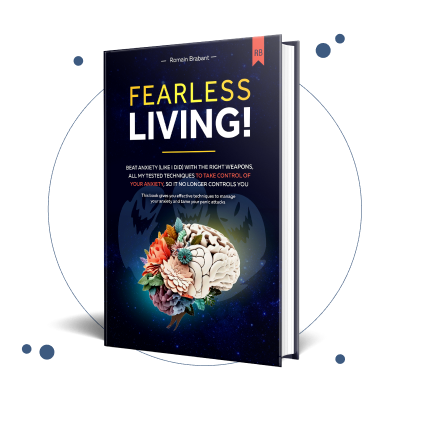
To stop catastrophic thinking, you can start by identifying the thought as a worst-case scenario, then gently challenge its probability with realistic evidence. This simple act of pausing and questioning creates a space of hope between you and the anxiety, breaking the automatic spiral toward disaster and paving the way to a calmer life.
Your Path from Panic to Peace Starts Here

If you’re exhausted by a mind that constantly jumps to the worst possible conclusion, you've found a place of genuine hope. Living with catastrophic thinking can feel incredibly isolating, but healing is possible, and this experience is far more common than you might realize.
It’s that automatic mental leap from a minor worry—like an unreturned text—to a full-blown disaster, like believing a friendship is over for good. This isn't about forced positivity or ignoring real concerns. It’s about understanding that you can find lasting relief from the relentless grip of anxiety and live a life that isn't dictated by fear.
You are not broken for experiencing this. Your mind is trying to protect you by anticipating every potential threat, but its alarm system has become overly sensitive. The good news is that you can recalibrate it and find your way back to peace.
This pattern is often linked to anxiety disorders, which affect a significant portion of the population. Globally, it's estimated that 4.4% of people live with some form of anxiety disorder, yet only a fraction ever receive support.
Recognizing these thought patterns is the first real step toward a calmer, more controlled, and panic-free life. Spotting them in the wild is easier than you think, and it's the beginning of your healing journey.
Recognizing Catastrophic Thoughts in Daily Life
Here's a quick look at common triggers and the distorted thoughts they can produce, helping you identify these patterns in your own experience.
| Everyday Situation | Anxious Thought | Catastrophic Leap |
|---|---|---|
| Getting a short email from your boss. | "They sound annoyed with me." | "I'm definitely getting fired for that mistake." |
| Your partner is quiet during dinner. | "They must be upset about something I did." | "Our relationship is falling apart." |
| Feeling a minor headache. | "This headache won't go away." | "It must be a brain tumor." |
| A friend doesn't reply to a text. | "Did I say something wrong?" | "They secretly can't stand me and the friendship is over." |
Seeing these scenarios laid out makes it clearer how quickly a simple worry can escalate into a full-blown catastrophe in our minds. The key is to catch that leap before it takes over, and that is a skill you can learn.
Sometimes, anxiety zeroes in on specific situations, making them feel impossible. For example, learning to conquer phone call anxiety offers practical skills that can be applied to other anxious thoughts.
Ultimately, taking the first of many anxiety recovery steps (https://anxietychecklist.com/anxiety-recovery-steps) is the key to moving forward with hope. This guide will provide practical strategies to help you do just that.
How to Gently Acknowledge Anxious Thoughts
When a terrifying thought pops into your head, what's your first instinct? For most of us, it's to fight it. Push it away. Argue with it.
But here’s the thing about trying to suppress an anxious thought: it’s like trying to hold a beach ball underwater. Sooner or later, it’s going to burst back to the surface with even more force.
A much more effective path to relief starts with a gentler approach: simply noticing the thought, without judgment.
This simple act creates a crucial sliver of space between you and the anxiety. Instead of getting swept away by the current of fear, you become an observer standing on the riverbank, just watching the thought float by. That mindful distance is where your power is. It’s the first real step toward understanding that you are not your thoughts and that you can be free from them.
The goal here is to interrupt the automatic spiral that can turn a simple worry into a full-blown catastrophe.
Name It to Tame It
A surprisingly powerful technique is to label the thought as soon as it appears. When your mind jumps to the absolute worst-case scenario, just pause and mentally say, "This is catastrophic thinking," or even just, "Catastrophizing."
This simple act of naming the pattern immediately dials down its emotional power, giving you back control.
Here’s how it looks in real life:
- The Vague Email: You get a one-liner from your boss: "Let's talk tomorrow." Before your mind races to "I'm getting fired," you can pause, take a breath, and label it: "That's a catastrophic thought."
- The Unusual Sensation: You feel a slight, weird pain in your side. Before you convince yourself it’s a life-threatening illness, you can acknowledge the pattern: "My brain is catastrophizing about my health again."
This simple label acts like a circuit breaker. It reframes the thought from an undeniable fact about the future into what it actually is—a product of an overprotective, anxious mind. It’s a moment of empowerment.
This isn’t about scolding yourself for having the thought. It's an act of compassionate self-awareness. Each time you successfully label a thought, you strengthen your ability to stay calm, grounded, and hopeful.
Tracking these moments can really help build the habit. In fact, exploring the many benefits of journaling for anxiety is a great way to get started. Learning to acknowledge these thoughts is the foundation for stopping catastrophic thinking for good.
Challenging the 'What Ifs' with Gentle Realism

Once you’ve gotten good at spotting a catastrophic thought, the next move isn’t to wrestle it into submission. It’s to gently question its authority.
This isn’t about starting an argument with yourself. Think of it more like a compassionate detective calmly examining the facts of a case, introducing evidence and a fresh perspective full of hope.
When a worst-case scenario takes hold, it feels incredibly real. The trick is to pause and create just enough space for curiosity to enter the picture. This is the heart of cognitive restructuring, a cornerstone of Cognitive Behavioral Therapy (CBT) that helps retrain your brain to seek balanced conclusions instead of defaulting to disaster.
This process gives you a powerful set of questions to dismantle fear piece by piece. With time, you build a new mental habit—one that brings you closer to living a panic-free life.
Your Gentle Questioning Toolkit
When a "what if" thought starts to spiral, you need a few go-to questions to ground yourself. Here are some that work wonders:
- "What's a more realistic or likely outcome?" Your mind immediately jumps to the 0.1% disaster scenario. Take a breath and consciously consider the 99.9% probability that things will be okay, or at the very least, manageable.
- "Have I survived a similar situation before?" The answer is almost always yes. Thinking back to your past resilience is a powerful reminder that you are more than capable of handling challenges.
- "What would I tell a friend who had this exact same fear?" We’re often much kinder and more rational with others. Applying that same compassionate logic to yourself can be a game-changer.
- "What's the actual evidence for this fear?" Try to separate your anxious feelings from the hard facts. More often than not, you'll find there’s little to no concrete evidence backing up the catastrophic prediction.
This isn't about pretending everything is perfect. It’s about challenging the distorted lens of anxiety and seeing the situation for what it truly is—not what your fear tells you it could be. This is how you reclaim your peace.
Learning to challenge your thoughts is a vital skill because it directly confronts the flawed logic that fuels anxiety. This type of thinking is just one of many common cognitive distortions that can trap you in a cycle of worry and fear. You can learn more about how to spot and challenge these patterns by exploring other common cognitive distortions (https://anxietychecklist.com/cognitive-distortions).
The Mind-Body Connection
This thinking style doesn't just mess with your head; it has a profound effect on your physical well-being, too.
Research into pain management has shown a powerful link between catastrophizing and physical symptoms. One study, for example, found that a staggering 92.6% of participants reported some level of catastrophic thinking about their pain. This directly correlated with increased impairment and a lower pain tolerance. By challenging your thoughts, you can often soothe your body, too.
Creating Your Personal Anxiety First-Aid Kit
When a catastrophic thought spiral hits, those first few moments are everything. Trying to reason with a mind that’s already in panic mode is a losing battle. What you need are immediate, practical tools that can anchor you back in the present. Think of it as building a personal anxiety first-aid kit—a go-to list of actions you have ready before the overwhelm takes over, giving you a sense of control and hope.
This isn't about diving into complex mental gymnastics. It’s about simple, physical interventions designed to calm your nervous system right now. The goal is to shift your focus from the terrifying "what ifs" spinning in your head to the solid, tangible reality of your body and your surroundings.
Sensory Grounding and Gentle Release
Your senses are one of the fastest gateways back to the present moment. When you’re stuck in a thought spiral, intentionally engaging them can pull you out.
- Temperature Shock: Grab an ice cube and hold it in your hand. The sharp, intense cold is almost impossible for your brain to ignore. It demands your attention, effectively breaking the loop of those repetitive anxious thoughts.
- Gentle Movement: Anxious energy builds up in the body and needs a release valve. This doesn't mean you need a full-blown workout. Simple actions like stretching your arms overhead, slowly rolling your neck, or even just taking a quiet walk around the room can help dissipate that pent-up nervous tension.
Another incredibly powerful technique is creating a designated "worry period." You set aside a specific, limited time each day—say, 15 minutes at 5 p.m.—to consciously let yourself worry. When a catastrophic thought pops up outside that scheduled time, you gently acknowledge it and tell yourself, "I'll deal with this during my worry time."
This strategy doesn't try to eliminate worry altogether, which is often impossible. Instead, it contains it. You're teaching your brain that you are the one in control of when and where you engage with anxious thoughts, proving that they don't have to hijack your entire day.
Physical reminders can also be a huge help in staying grounded. Many people find tools like anxiety coping cards useful for getting quick, actionable prompts when they feel overwhelmed and can't think clearly.
This infographic breaks down a simple three-step mindfulness practice for when a triggering thought shows up.

As you can see, the key isn't to fight the thought. It's about noticing it without judgment, grounding yourself in the feeling of your own breath, and then gently guiding your focus back to what's real and right in front of you. This is a practice of hope.
Shifting Your Focus to What You Can Control

Catastrophic thinking thrives on uncertainty. It feeds on that sinking feeling of powerlessness, making you feel like a passenger in your own life. But one of the most effective ways to slam the brakes on this spiral is to reclaim your sense of agency.
It’s about consciously shifting your energy away from the swirling vortex of uncontrollable worries and pouring it into things you can actually influence. This simple pivot is a game-changer for your healing.
When your mind spins out, it’s usually fixated on a hypothetical disaster way outside your immediate control. The trick is to yank that precious mental energy away from the "what ifs" and channel it into small, concrete steps you can take right now. This move chips away at the helplessness and starts building real, lasting resilience.
This is especially critical when you're battling exhaustion. Research shows a clear link between high levels of catastrophic thinking and severe fatigue. The more we catastrophize, the more drained we become, locking us in a draining cycle. In fact, one study highlighted how this connection between fear, avoidance, and fatigue can become deeply entrenched.
Creating Your Circle of Control
Here’s a practical way to put this into action. The next time a specific worry hijacks your thoughts, grab a piece of paper and draw a big circle. It’s a simple exercise, but it’s powerful.
- Inside the circle, jot down every single thing about the situation you can directly influence. Think: your actions, your responses, where you choose to put your focus, the effort you put in.
- Outside the circle, list all the elements you absolutely cannot control. This usually includes other people’s reactions, external events, or the ultimate outcome.
This visual tool makes it crystal clear where your energy is best spent. You move from being a passive worrier, stuck on the uncontrollable, to an active problem-solver, focused on what you can actually manage. This is how you build a panic-free life, one small action at a time.
This is a core strategy for tackling overthinking and anxiety (https://anxietychecklist.com/overthinking-and-anxiety) because it grounds you in productive action instead of letting your thoughts run wild. Engaging in tangible, constructive tasks can also be a fantastic mindful outlet. For example, learning about planning a garden (https://homegrown-garden.com/blogs/blog/how-to-plan-a-garden) can be a grounding way to focus on something you can literally build and nurture from the ground up.
Got Questions? Let's Talk.
It's completely normal to have questions when you start untangling catastrophic thoughts. Getting clear on a few key things can make the whole process feel less intimidating and, honestly, a lot more hopeful.
You're not alone in wondering about this stuff. Just asking these questions is a huge step toward getting back in the driver's seat of your own mind and on the path to healing.
https://www.youtube.com/embed/8-2WQF3SWwo
Can I Stop Catastrophic Thinking Forever?
Let’s be real: trying to eliminate these thoughts completely is a recipe for more stress. It’s like trying to stop the ocean from having waves. It’s just not going to happen.
The actual goal is much more achievable and hopeful: changing your relationship with these thoughts.
You'll get quicker at spotting a catastrophic thought the moment it pops up. That speed is your superpower because it shrinks the thought's power over you, stopping it from hijacking your emotions. It’s about building resilience, not chasing some impossible idea of a perfectly quiet mind. Every single time you catch a thought spiral and interrupt it, you're healing. You are moving toward a panic-free life.
How Long Until I See Improvement?
This isn't a race, and everyone's timeline is different. The most important thing you can do is be kind to yourself through the process. Some people start feeling a real shift in awareness within just a few days of consistently using these strategies.
Deeper, more lasting change usually takes a few weeks of practice. Every small win is a win. Celebrate it. It means you’re on the right path to a life with less panic and more peace.
This isn't about sprinting to a finish line. It's about slowly and deliberately building new mental habits that actually work for you, one thought at a time. Consistency beats speed, every time. Healing is a journey, and you are already on your way.
What If These Techniques Are Not Enough?
The strategies in this guide are incredibly powerful, and for many, they are enough to make a massive difference. But they're not a replacement for professional mental healthcare.
If your catastrophic thinking feels severe, relentless, or is tied to a diagnosed anxiety disorder, reaching out for professional help is a sign of incredible strength, not weakness. It is a profound act of hope.
A therapist who specializes in Cognitive Behavioral Therapy (CBT) can give you a personalized roadmap and support you in ways a self-help guide can't. Asking for help might just be the most courageous and hopeful thing you ever do for yourself. A panic-free life is absolutely possible, and sometimes a guide can help you get there.
Ready to put all of this into practice? The Anxiety Checklist gives you a clear, step-by-step system to dismantle anxious thought patterns and build a calmer mind. Get the tools you need to start living more fearlessly today at https://anxietychecklist.com.

